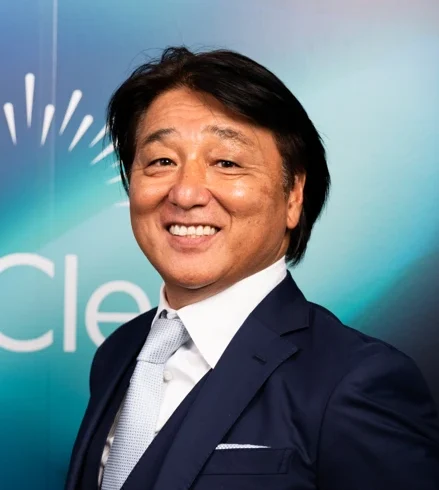Takeshi Fujiwara

General Manager at Cutera
Cutera’s Japan business under General Manager Takeshi Fujiwara is shaped by a clear vision, a disciplined organizational philosophy, and a commitment to clinically relevant innovation anchored by customer trust and internal professionalism. The result is a business culture that pursues leadership in the aesthetics market while aligning people, process, and product to create durable value for physicians and patients. This editorial examines Fujiwara’s management approach, its translation into market actions, and the human-centered values that animate the company’s forward path, drawing directly from his questionnaire responses.
Vision, Professionalism, and Independent Thinking
From the outset of our discussion, it was clear that Fujiwara defines Cutera’s goal as becoming the premier provider in the esthetic market, with the organization designed to always be ready to deliver the latest and best products and services. Readiness here is not a slogan; it is an operational standard that includes product quality, regulatory precision, and a service capability that can stand alongside the clinical demands of medical customers. His recent note about obtaining regulatory approval in Japan for a laser device used in acne treatment underscores the company’s emphasis on technology that answers specific clinical needs while meeting strict national standards. The strategy places clinical credibility at the core of differentiation, establishing a platform from which education, adoption, and trust can scale across the physician community.
Success in medical aesthetics depends on more than launch dates and device features. Fujiwara emphasizes that sales teams must converse with physicians as technical peers, not just as product representatives. To that end, the company invests in structured education programs and encourages individual initiative in learning, with the aim of raising the level of engagement and credibility in daily doctor interactions. This approach is paired with a service organization that invites external validation; Fujiwara shared the pride felt across the company when CUTERA’s TEC Service received positive evaluations from both customers and competitors, and he made a point to celebrate that feedback broadly within the team. The combination of technical literacy in sales and maturity in service support forms a customer experience that is difficult for rivals to copy quickly.
Fujiwara identifies a distinct turning point in organizational development: the moment when both the company and its people can think and act independently. He observes that many Japanese organizations excel at diligence and compliance but may not be accustomed to proposing new approaches, which can hinder innovation in fast-moving fields. His answer is a deliberate culture design that encourages expressing one’s opinions, rewards initiative in real time, and normalizes management-minded behavior at all levels. He builds this by consistently communicating expectations and recognizing independent actions as they happen, creating an environment where ideas are welcomed and action is valued. Over time, this produces agility, speed, and creativity that align with market dynamics.
Motivation, Partnerships, and Organizational Agility
Fujiwara measures success in human terms as well as financial ones. He regularly asks dedicated employees whether their work is interesting and whether the company feels interesting, using these questions as a barometer for organizational health. Several drivers contribute to a “yes” answer, including visible company growth, recognition of personal aspirations, and proper evaluation of effort. Compensation design follows the same logic, offering attractive salaries to motivated employees to reinforce the link between initiative and reward. He also integrates customer feedback directly into internal morale, sharing praise for service excellence broadly and quickly to reinforce the meaning and impact of the team’s work.
Partnerships, in Fujiwara’s view, must be win-win, contribute to society, and support mutual growth over time. He recalls past disputes over profit distribution and how he reframed the relationship with partners: one team, one set of market competitors, and a shared commitment to bring better solutions to the world. Profits, he argues, follow success, and success requires a period of investment and loss that should be shared equitably by both sides. Collaborations built on this principle have delivered strong results and continue to expand, demonstrating that aligned incentives and shared risk create durable partnerships in healthcare technology.
The longer we spoke, the more a pattern emerged—Fujiwara rejects static organizational design and instead favors tailoring structure to current circumstances in order to achieve the most effective form. He points to the rapid advancement of AI as a change driver comparable to the arrival of email or mobile phones, requiring timely integration and thoughtful training across the company. This adaptive stance is enabled by transparency, regular alignment forums, and continuous education so that the team can keep pace with market shifts and technology evolution without losing sight of safety and quality.
Compliance, Education, and Strategic Leadership
Healthcare demands strict rule enforcement, and Fujiwara supports that baseline unequivocally. At the same time, when regulations lag real-world practice, he believes industry groups should engage the government to update frameworks responsibly and on time. This balanced posture enables innovation to advance within a robust compliance environment while avoiding stagnation that can arrive when policy trails technology by too long a distance. The company’s acne treatment innovation in Japan reflects the value of that approach, translating advanced technology into a regulated solution that clinics can trust.
Laser-based therapies often depend on practitioner skill for outcomes, which can create variability in results across settings. Fujiwara’s solution is to strengthen systems that enhance consistency, including tools that control instruments more precisely and feedback mechanisms that verify the accuracy of treatment in real time, guided by a continuous learning culture. Together with professional education, these approaches support safer and more reliable outcomes across diverse clinics, aligning with physicians’ expectations for reproducibility.
Monthly all-employee meetings create a cadence for recognizing progress and aligning on goals, while continuous education ensures that new information flows quickly across the organization. Newcomers receive focused training on cosmetic medicine fundamentals, and the company integrates guidance on AI during these sessions to ensure a shared understanding of emerging tools. These rituals reinforce cohesion and maintain a common operating picture across departments, which is especially important in regulated markets.
Maintaining leadership requires speed, clarity, and consistent delivery. Fujiwara believes a company that runs at the top sees new opportunities first, while those in second place see only the leader ahead. The company’s strategy in Japan reflects this mindset: invest in innovations that matter clinically, support adoption with high-caliber education and service, and keep the organization aligned around goals that are measurable and meaningful. This competitive stance is not about chasing every trend but about focusing on technologies and practices that improve patient outcomes and physician confidence.
Technology Outlook, Innovation in Acne Care, and the Road Ahead
Fujiwara expects AI, robotics, and smart diagnostics to advance along separate yet converging paths, with new devices incorporating these technologies in ways that can improve quality, safety, and usability. He emphasizes that beauty is rooted in human emotion and that the relationships connecting device suppliers, physicians, and patients will remain central to care experiences and outcomes. As digital communication deepens between clinics and patients, he anticipates growth in home care scenarios that complement clinic-based treatments without replacing the human connection that defines the field.
Across global markets, energy-based acne solutions have gained prominence as non-pharmaceutical alternatives that target sebaceous gland activity at the source. Cutera’s AviClear platform exemplifies this category with a 1,726 nm wavelength designed to selectively target and suppress sebaceous gland function for mild to severe inflammatory acne. Treatment programs commonly emphasize a series-based approach with session times measured in minutes, supported by contact cooling to protect surrounding structures and promote patient comfort. Clinical narratives emphasize durability of results and applicability across skin types, reinforcing the value case for physicians evaluating device-based acne care. While Fujiwara’s questionnaire referenced the company’s regulatory milestone in Japan, the broader clinical context highlights why such milestones matter for both safety and efficacy in routine practice.
Before we wrapped up, Fujiwara’s focus on the future was evident. The next chapter for Cutera in Japan depends on preserving the alignment between culture, capability, and customer outcomes. Fujiwara’s blueprint emphasizes clarity of mission, strict compliance in healthcare, readiness to advocate for regulatory updates when warranted, and a management mindset present at every level of the organization. It also prizes a service reputation that earns external validation, a sales force that can speak the language of medicine, and a partnership philosophy that aligns incentives from day one. These elements combine to create an organization that moves quickly, learns continuously, and treats people as the bedrock of performance.
Editorial Closing
What distinguishes Fujiwara’s approach is not the presence of a single breakthrough but the consistency with which values are translated into systems. He measures success by the energy people feel in their work and the meaning they derive from it, then aligns compensation, recognition, and education to sustain that energy over time. He structures partnerships to share early risk and rewards, which sets conditions for long-term durability. He plans for technological change by investing in learning and transparency rather than hoping structure alone will keep pace. And he celebrates wins in a way that strengthens community, which often proves decisive when markets turn turbulent.
In a field where credibility is earned one clinic at a time, this model gives Cutera a distinct competitive advantage. It couples rigor with humanity and marries innovation with responsibility. The result is a business that can aim for premier status without losing the qualities that make leadership sustainable: trust, clarity, discipline, and a culture that treats initiative as a daily practice rather than a slogan.
Quotes
“Leadership is not about control, but about inspiring others to believe in what they can achieve.”
“In every challenge lies an opportunity to innovate and grow.”
“Success is a journey shaped by perseverance, adaptability, and vision.”
“True leaders leave behind not just results, but a legacy of empowerment.
